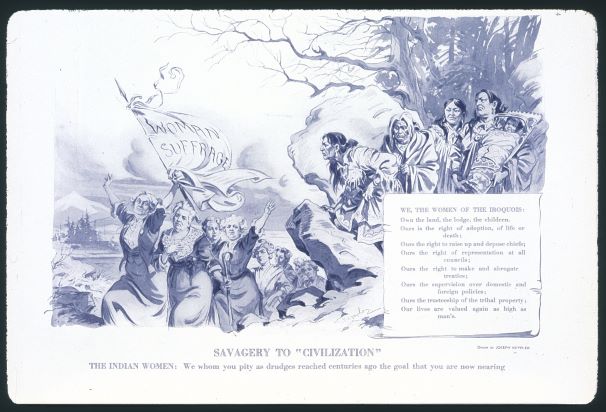Lesson 1
For the first lesson, we will be learning about the development of the patriarchy (male dominant societies) and how this influenced early White women in the United States. This lesson will look at how some of the ideas that White women brought up at the Seneca Falls Convention were taken from Native Americans and how these movements were willing to secure their own rights at the expense of others.
WATCH:
READ:
The waves of feminism, and why people keep fighting over them, explained
Iroquois Women Inspire 19th Century Feminists
1848 Declaration of Sentiments–Seneca Falls Convention

WATCH:
Discussion Questions
- What is your definition of feminism? What has feminism accomplished?
- Do you think that feminists such as Elizabeth Cady Stanton and Susan B. Anthony were practicing settler colonialism by erasing Native American women from the Seneca Falls convention?
- Who was included in the early feminist movement? Who was excluded?
- What were women asking for in the Declaration of Sentiments? Do you think it was unreasonable? How is that document similar to the Declaration of Independence? How are they inspired about similar ideas about equality?
Lesson 2
For this second lesson we will be exploring the concept of intersectionality. Intersectionality was developed by Kimberle Crenshaw to specifically discuss the type of discrimination that Black women face. This concept has been instrumental in understanding how people can have different experiences based on the different types of oppression they fall under. Students will examine some stereotypes and issues that women who are not middle class and White face.
WATCH:
LISTEN:
WATCH:
READ:
The Combahee River Collective Statement
Rethinking Work-Life Balance for Women of Color
Discussion Questions
- How does White supremacy culture show up in White feminism?
- How are the Combahee River Collective statement and the Seneca Falls Declaration of Sentiments similar? How are they different? How is the Combahee River Collective intersectional?
- What are some of the different issues that women of color face that White feminism ignores? How far back can these issues be traced?
- How can intersectionality be used beyond race and gender? How can it be used to think about sexuality, class, religion, immigration status, etc…?